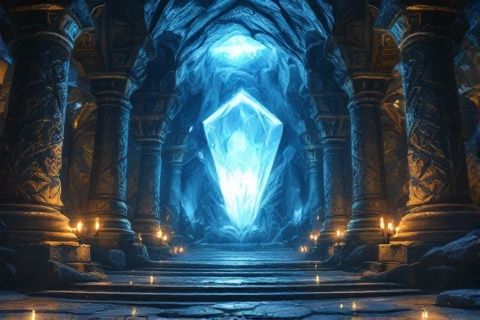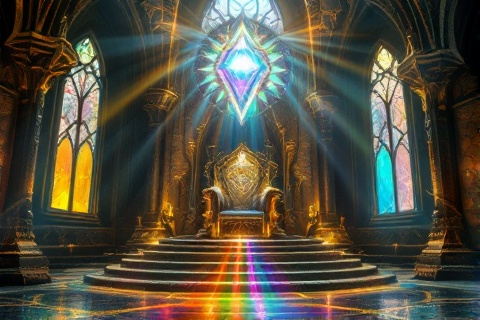
Arkenstone: The Heart of the Mountain
The Dwarves' Shining Gem and the Quest for Erebor
Discovery in the Heart of Erebor

The discovery of the Arkenstone occurred in the early Third
Age during the prosperous reign of Thráin I, who established
the Kingdom under the Mountain after fleeing
Moria. Deep within the heart of Erebor, dwarven miners
uncovered this extraordinary gem while delving into the mountain's lowest
depths, marking a pivotal moment in the history of Durin's
Folk.
The precious stone was found in the deepest mining shafts of Erebor, far below
the great halls and forges of the dwarven kingdom. In chambers where the very
roots of the mountain seemed to touch the foundations of the earth, the miners
discovered a cavern that held this remarkable jewel, set within ancient stone
formations that had remained undisturbed for countless ages.
The Arkenstone possessed a crystalline structure that set it apart from all
other gems found in Middle-earth, including the famed
jewels of Valinor. Its unique internal structure created
patterns of light that seemed to dance within its core, suggesting a creation
process unknown even to the most knowledgeable dwarven craftsmen of the age.
Physical Characteristics
The Arkenstone manifested as a magnificent globe-shaped white gem, remarkable
not only for its size but for its perfect spherical form. Its smooth surface
appeared to have been crafted by nature itself, though its perfection suggested
divine influence in its creation. The white crystalline material seemed to
possess an inner radiance that shone even in darkness.
What truly set the Arkenstone apart was its extraordinary ability to capture and
transform light. When illuminated, the gem would not simply reflect light but
would scatter it in countless rainbow hues, creating a spectacular display that
earned it renown throughout Middle-earth. This property made it appear as though
the stone contained countless smaller gems of various colors, each twinkling
with its own inner fire.
The size of the Arkenstone was considerable, approximately matching the span of
a human hand, making it one of the largest precious stones ever discovered in
Middle-earth. Its substantial dimensions allowed its remarkable properties to be
visible even from a distance, contributing to its impressive presence when
displayed.
The stone's description as a 'heart of living light' was not mere poetic
flourish but an accurate description of its appearance. The gem seemed to pulse
with an internal radiance that gave it an almost organic quality, as though it
were indeed a living thing rather than an inanimate object. This characteristic
led many to believe it possessed properties beyond those of ordinary gems.
Symbol of Divine Blessing

The dwarves of Erebor interpreted the discovery of the Arkenstone as a divine
blessing from their creator, Aulë the Smith. They believed that such a perfect
and unique gem could only have been created by the Vala who had
shaped their race, and its discovery was seen as a sign of his continued favor
toward Durin's Folk.
The gem's elevated status as the King's Jewel established it as the supreme
symbol of authority within Erebor. Its possession became inextricably linked
with the right to rule, and each king who held it saw their legitimacy
strengthened through this tangible connection to their kingdom's greatest
treasure.
The belief in Aulë's blessing of the Arkenstone was reinforced by its unique
properties, which seemed to exceed the natural capabilities of ordinary gems.
The dwarves saw in its light a reflection of the divine fire of creation that
their maker, whom they called Mahal, had used in crafting the first dwarves from
stone.
Cultural Significance to the Dwarves
As the greatest treasure of Erebor, the Arkenstone became the foremost symbol of
the prosperity and power of Durin's Folk. Its presence in the throne room of
Erebor represented not just material wealth but the culmination of dwarven craft
and culture. The stone's splendor testified to the kingdom's status as the
greatest dwarven realm of the Third Age.
The Arkenstone held a central role in the ceremonies and traditions of Erebor's
royal court. During the coronation of new kings, the stone served as a focal
point of the ritual, its presence blessing the succession and connecting each
new ruler to the line of Durin through an unbroken chain of tradition and
authority.
The people of Erebor derived a significant portion of their cultural identity
from the presence of the Arkenstone in their midst. It represented not only
their wealth and craftsmanship but also their special place among the dwarven
kingdoms. The gem became a source of pride that united all levels of their
society, from miners to nobles.
Craftsmanship and Setting

The finest dwarven craftsmen of Erebor devoted their skills to enhancing the
natural beauty of the Arkenstone. While the gem required minimal cutting due to
its natural perfection, master artisans carefully refined its surface to
maximize its light-capturing properties. Their work respected the stone's
inherent qualities while subtly improving its ability to display its inner
radiance.
A specially designed mounting was created to showcase the Arkenstone to its full
potential. This masterwork of dwarven metalcraft incorporated precisely angled
surfaces and carefully positioned light channels that worked in harmony with the
gem's natural properties to enhance its brilliant display.
The position of the Arkenstone above the throne of Erebor was carefully chosen
to maximize its impact. Placed high in the great hall where light from carefully
positioned shafts could strike it throughout the day, the stone cast its rainbow
illumination across the throne room, creating an awe-inspiring display of light
that emphasized the majesty of the kingdom.
Loss and Legacy
The catastrophic arrival of Smaug in T.A. 2770 marked the
beginning of the Arkenstone's separation from its rightful guardians. In the
chaos and destruction of the dragon's attack, the gem was lost among the
countless treasures that Smaug claimed for his hoard. This loss represented not
just the disappearance of a precious stone but the severance of a spiritual
connection between the dwarves and their kingdom.
During the long years of exile, the Arkenstone transformed into a powerful
symbol of the dwarves' lost heritage and homeland. Stories of its beauty and
significance were passed down through generations, keeping alive the memory of
Erebor's glory and fueling the desire to reclaim their ancient home.
The presence of the Arkenstone in Smaug's hoard became a driving force that
inspired generations of Durin's Folk to dream of returning to Erebor. The gem's
recovery became synonymous with the reclamation of their homeland, representing
not just material wealth but the restoration of their people's dignity and
rightful place in Middle-earth.
Role in Dwarven History

The presence of the Arkenstone in Erebor served as a powerful diplomatic tool
that helped unite the seven families of the dwarves under the
influence of the Lonely Mountain. The gem's splendor and the prestige it
conveyed helped establish Erebor as the preeminent dwarven kingdom of the Third
Age, encouraging cooperation and alliance among the scattered dwarf realms.
The fame of the Arkenstone enhanced Erebor's trading relationships with
neighboring kingdoms, including Dale and the woodland realm of the Silvan
Elves. The gem's reputation drew merchants and diplomats from
distant lands, contributing to Erebor's position as a crucial center of trade
and cultural exchange in northern Middle-earth.
During the golden age of the Lonely Mountain, the Arkenstone stood as a symbol
of the unprecedented prosperity enjoyed by the dwarves of Erebor. Its presence
coincided with a period of extraordinary achievements in craft, trade, and
diplomacy that established the Kingdom under the Mountain as one of the most
powerful realms in Middle-earth.
